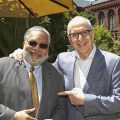Lonnie G. Bunch III installed as 14th Smithsonian Secretary
Chief Justice welcomes new Secretary with key to the Castle
Lonnie G. Bunch III, founding director of the Smithsonian’s National Museum of African American History and Culture, was installed as the 14th Secretary of the Smithsonian Institution during a ceremony held Nov. 1 at the Arts and Industries Building on the National Mall. The Hon. John G. Roberts, Jr., Chief Justice of the United States and Chancellor of the Smithsonian, presided over the ceremony and presented Bunch with a ceremonial brass key that once opened a massive oak door of the Smithsonian Castle.
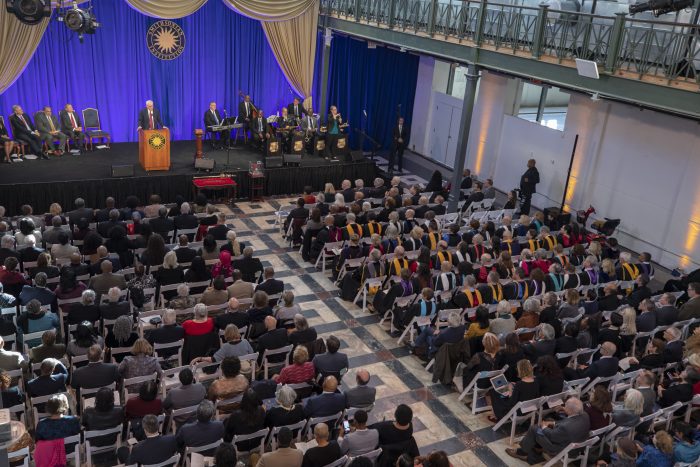
Installation ceremony of the 14th Secretary, Lonnie G. Bush III, in the historic Arts and Industries Building. Nov. 1, 2019 (Photo by Rob Stewart)
In his remarks, Bunch outlined his vision of a forward-looking institution with “the courage to make lasting change for the benefit of humanity.”
Bunch is the first African American, the first historian and the first Smithsonian museum director to assume the position of Secretary. He began his post June 16. As Secretary, Bunch oversees 19 museums, 21 libraries, the National Zoo and numerous research centers, including the Smithsonian Astrophysical Observatory, the Smithsonian Tropical Research Institute and the Smithsonian Environmental Research Center. He is responsible for an annual budget of $1.6 billion, 6,300 employees and 7,300 volunteers.
The Installation Ceremony
The ceremony began with a presentation of the Colors by the Smithsonian Honor Guard and the singing of the National Anthem by singer, songwriter and Washington, D.C., native Kenny Lattimore. Welcoming remarks were made by David Rubenstein, chair of the Smithsonian Board of Regents and Steve Case, chair-elect.. Regent Risa Lavizzo-Mourey closed the ceremony. (Learn more about the history of the Smithsonian installation ceremony and its symbols.)
A musical prelude with the Smithsonian Jazz Masterworks Orchestra began the ceremony followed by an academic procession of Smithsonian scholars, highlighting the Smithsonian’s rich history of diverse scholarship and expertise. A member of the Smithsonian Honor Guard led the procession carrying the Institution’s ceremonial mace.
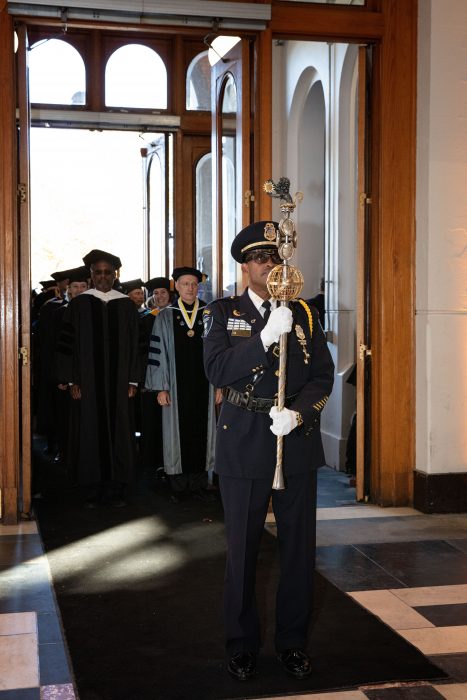
The presentation of the ceremonial Smithsonian mace precedes the Academic Procession into the Arts and Industries Building (Photo by Jaclyn Nash, Nov. 1, 2019)
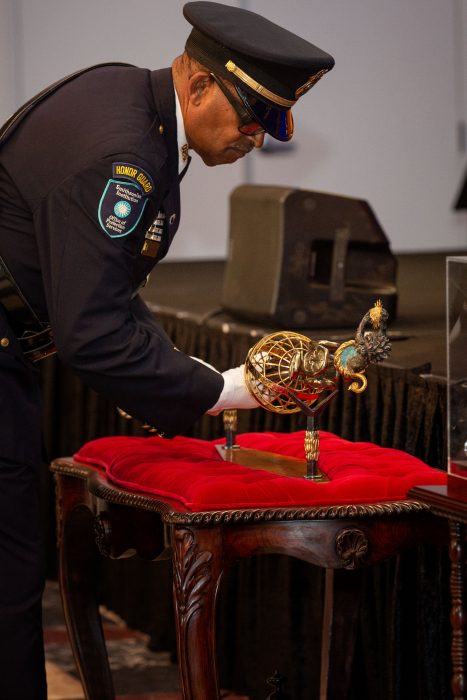
Smithsonian Honor Guard member William Greenwood presents the ceremonial Smithsonian Mace. (Photo by Jaclyn Nash, Nov. 1, 2019)
The procession was a representative version of the centuries-old tradition at universities, featuring scholars wearing robes and hoods symbolizing their fields of study and level of academic achievement. Today’s procession of 54 Smithsonian scholars, curators and experts represented their colleagues and showed the Institution’s breadth of expertise across dozens of disciplines and its foundational commitment to James Smithson’s mandate “for the increase and diffusion of knowledge.”
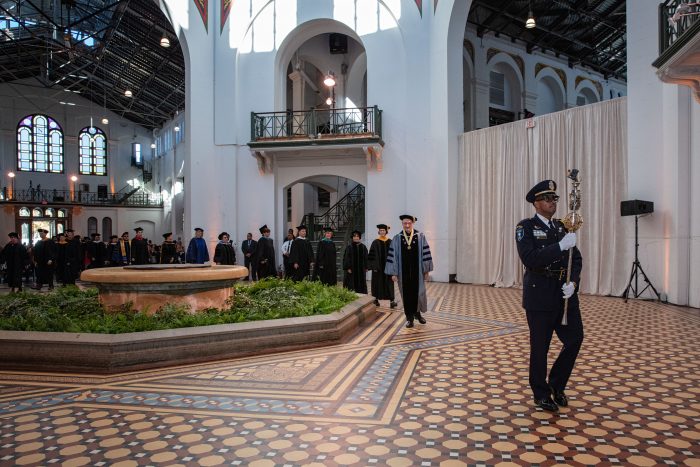
The procession of Smithsonian directors and curators in academic robes is a traditional part of the installation ceremony. Nov. 1, 2019. (Photo by Jaclyn Nash.
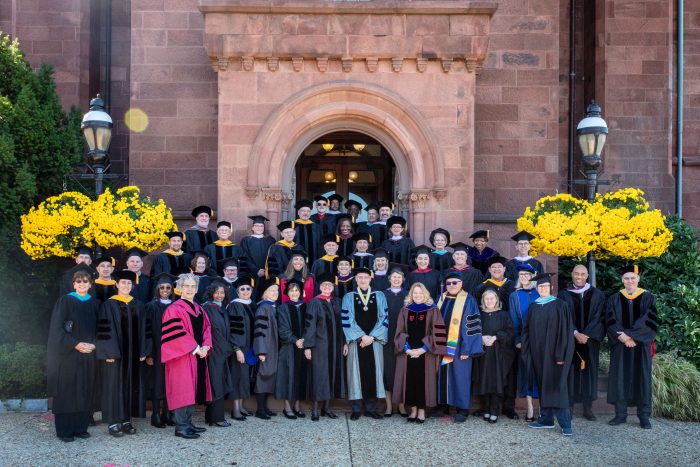
Smithsonian directors and curators in academic robes are traditional part of the installation ceremony. Nov. 1, 2019. (Photo by Jaclyn Nash.
Eleanor Harvey, senior curator at the Smithsonian American Art Museum, welcomed the Secretary on behalf of the Smithsonian’s staff and volunteers. Next came remarks from former Smithsonian Secretary David Skorton, who retired from the position in June.
After delivering brief remarks, Chief Justice John G. Roberts, Jr. presented Bunch with the ceremonial key, a symbol of the Office of the Secretary of the Smithsonian. Bunch’s 15-minute installation address followed the presentation. The program concluded with Lattimore performing “Lift Every Voice and Sing.”
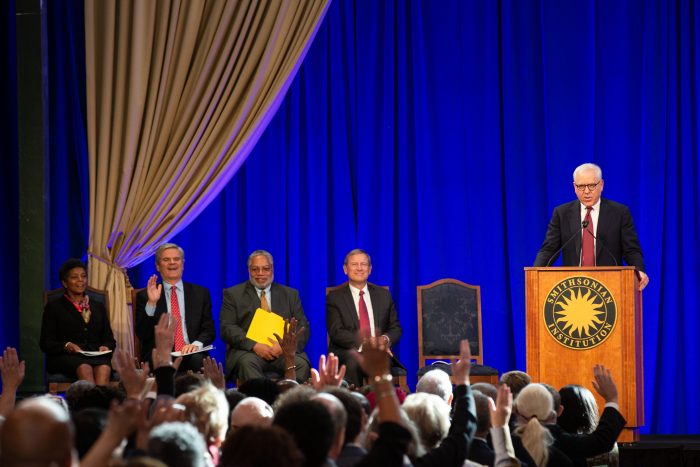
From left, Regent Risa Lavizzo-Mourey, Regent Steve Case, Secretary Lonnie Bunch III and Chief Justice of the United States John Roberts listen to introductory remarks from David Rubenstein, chair of the Board of Regents. (Photo by Jaclyn Nash)
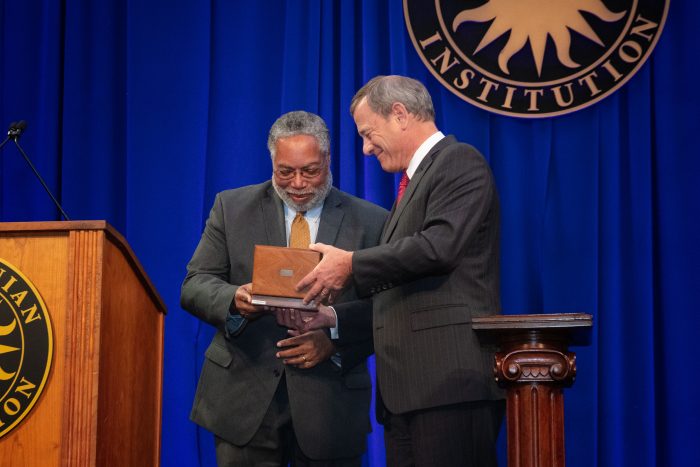
Chief Justice John Roberts presents Secretary Lonnie Bunch with the ceremonial key to the Smithsonian Castle. Nov. 1, 2019. (Photo by Jacklyn Nash)
“The Smithsonian has always been a forward-looking institution, a place to capture innovation and document it, a place to make innovation accessible to broader populations,” Bunch said. “I am deeply proud of our legacy and even prouder of the work we do now.” (Read the the Secretary’s remarks as prepared for the ceremony.)
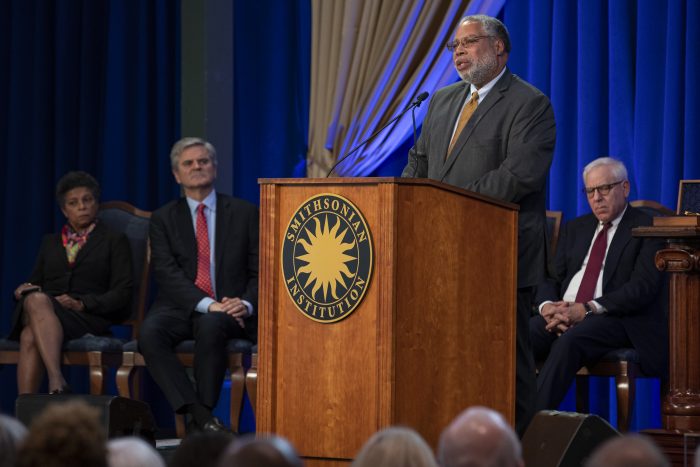
Lonnie Bunch III, 14th Secretary of the United States delivers remarks at his installation ceremony, Nov. 1, 2019. On stage, from left, Regent Risa Lavizzo-Mourey, Regent Steve Case, and David Rubenstein, Chair of the Board of Regents. (Photo by Jaclyn Nash.
Bunch has spent more than 35 years in the museum field and is regarded as one of the nation’s leading figures in public history and museum communities. He was named director of the National Museum of African American History and Culture in 2005. He also served as director of the Chicago Historical Society and as a senior curator at the Smithsonian’s National Museum of American History. His recent book, A Fool’s Errand: Creating the National Museum of African American History and Culture in the Age of Bush, Obama, and Trump (Smithsonian Books, 2019), chronicles the creation of the first national museum dedicated to African American history and culture. (Learn more about Secretary Bunch’s career.)
The Smithsonian Mace
The Smithsonian Mace was commissioned in 1964 by the Institution in anticipation of the celebration of the bicentennial of the birth of the Smithsonian’s benefactor and namesake, James Smithson. The 47-inch mace was unveiled in September 1965, a gift from friends of the Smithsonian. It is made of gold and silver and encrusted with diamonds, rubies and polished Smithsonite, a mineral identified by James Smithson and named for him posthumously in 1832.
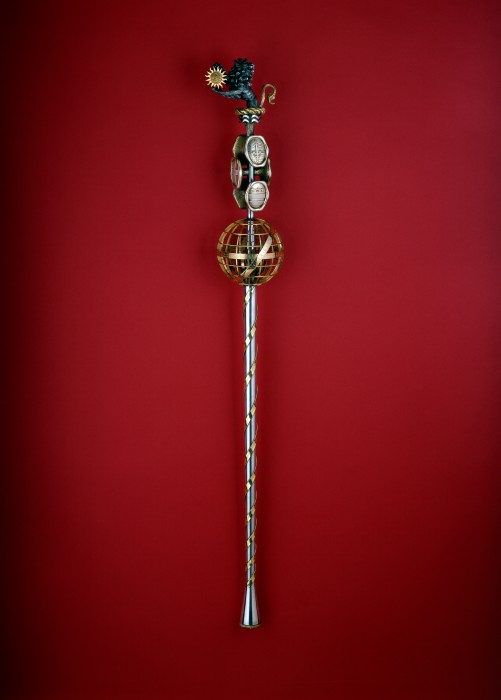
The Smithsonian Mace (Photo by Jeff Ploskonka)
The demi-lion holding a golden sun that tops the mace was adapted from the crest figure of the coat of arms of James’ father Sir Hugh Smithson. Traditionally, the sunburst signified “the light of heaven” and “the fountain of life.” The lion rests on a piece of Smithsonite. The shaft of the mace is entwined with a gold ribbon engraved with the names and terms of office of the first eight Smithsonian Secretaries.
The Badge of Office
The Smithsonian’s Badge of Office was conceived of and fabricated at the same time as the mace. It is a thick, irregularly shaped medallion made of 18-carat gold that hangs from a cherry-red ribbon. Cast in high relief and set within a deeply recessed square on the front is the owl of Athena, a symbol of wisdom, and an olive branch, a symbol of peace and goodwill. The owl has forward-gazing eyes that are set with a pair of large, yellow sapphires. To the side of the owl is engraved the Institution’s original mandate as defined in Smithson’s will: “For the Increase and Diffusion of Knowledge Among Men.” The back is engraved with the sunburst seal of the Smithsonian and “James Smithson, 1765—Bicentennial 1965.”
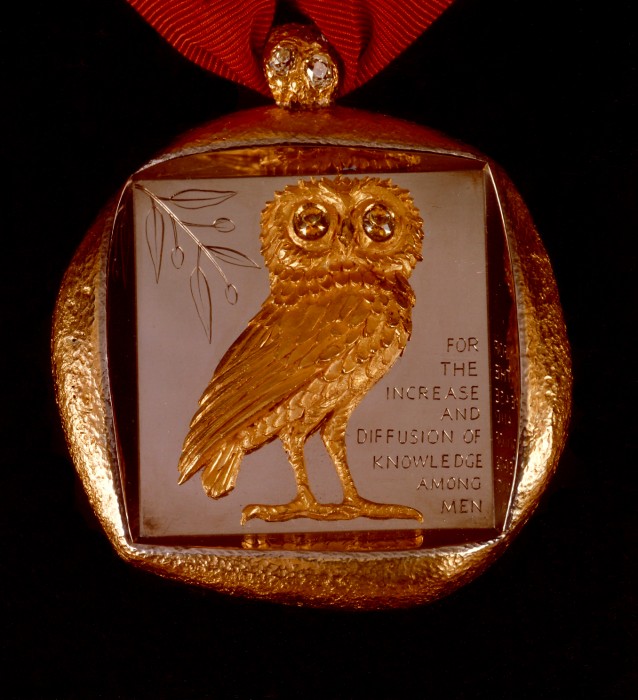
The Smithsonian’s Badge of Office.
The Ceremonial Key
The tradition of passing the Smithsonian key to the incoming Secretary originated for the 1964 induction of S. Dillon Ripley as the eighth Secretary. The Secretary is not a Cabinet-level position requiring Senate confirmation, and therefore there is no swearing in ceremony. In lieu of that, the presentation of the key by the Chief Justice was initiated in 1964 when Chief Justice Earl Warren presented the key to Ripley. The large brass key dates to the mid-19th century.
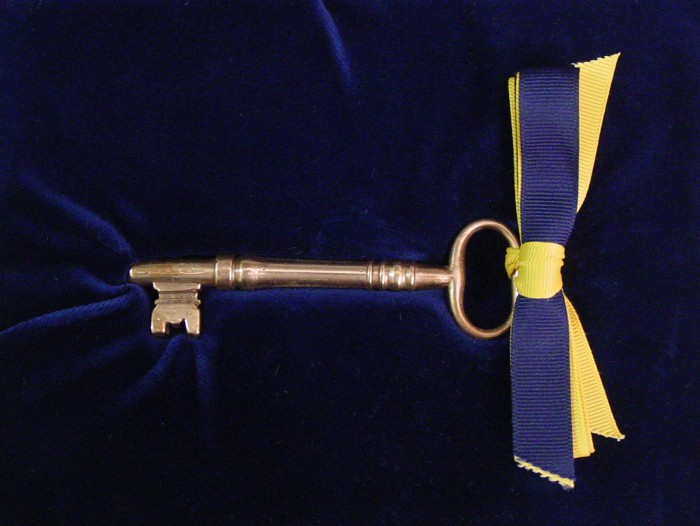
The ceremonial key to the Smithsonian Castle.The Arts and Industries Building
The Arts and Industries Building, which opened in 1881 as the U.S. National Museum, closed in January 2004 to undergo a structural evaluation and extensive renovation. Since 2016, the building has hosted temporary exhibitions and special events. This is the second installation ceremony to be held in the building (Skorton’s ceremony was here in October 2015). The Arts and Industries Building was designed by Adolf Cluss and Paul Schulze and opened to the public in 1881.
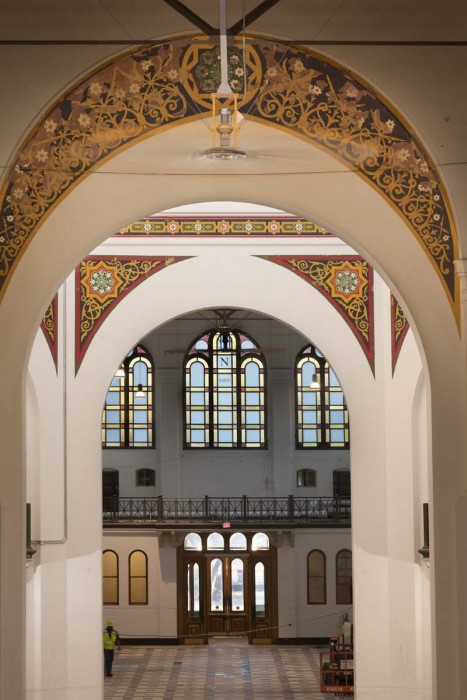
Photo by Eric Long
The building was partially restored to its Victorian appearance for the 1976 U.S. Bicentennial celebration, when it housed a re-creation of the 1876 Philadelphia Centennial Exposition. After the Bicentennial exhibition, it housed offices and remained open to the public for temporary exhibitions.
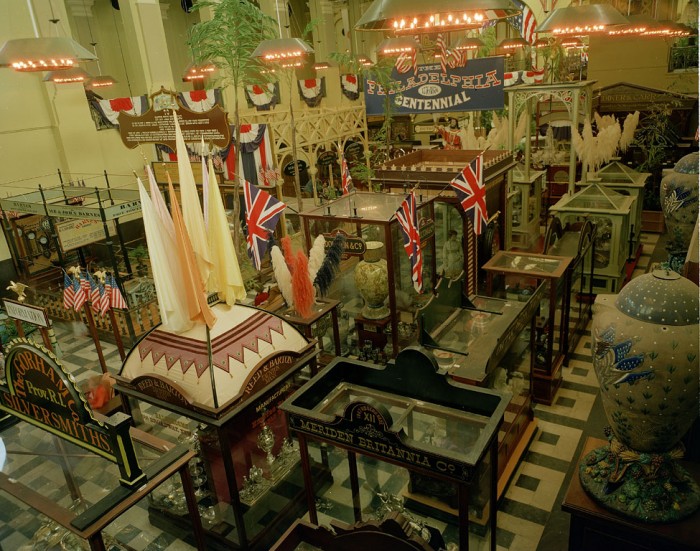
The “1876: A Centennial Exhibition,” a recreation of the Philadelphia Centennial Exhibition in 1876, in the Arts and Industries Building and opened May 10, 1976. This section displays industrial wares by such companies as Reed & Barton, Doulton & Co., and Meriden Britannia Co. (Photographer unknown)
Posted: 4 November 2019
-
Categories:
Administrative News , Feature Stories , History and Culture , News & Announcements
